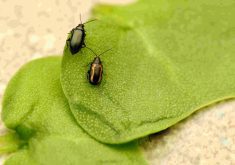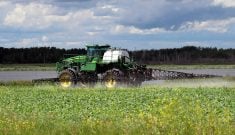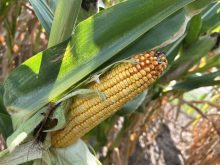Last year’s aphid problems have become this year’s near absence.
Farmers are not fighting with aphids this year, according to the province, a departure from last year when levels prompted insecticide applications in a wide variety of crops from wheat to canary seed.
“We’ve got lots of people out looking for aphids and, in most cases, the news has been pretty good,” Manitoba Agriculture entomologist John Gavloski said in a recent webinar.
Aphids were among Manitoba’s largest insect concerns last year. The 2017 Manitoba Agriculture insect summary noted problems with both English grain aphids and oat-birdcherry aphids in cereals, with the latter also bringing the risk of barley yellow dwarf virus.
Read Also

Manitoba Ag Days 2026 coming up fast
Canada’s largest indoor farm show, Manitoba Ag Days, returns to Brandon’s Keystone Centre Jan. 20-22, 2026. Here’s what to expect this year.
The report went on to note “noticeable levels” of turnip aphids in northwestern canola fields, high levels in sunflowers, although no spray passes were reported, and a variety of aphids in potatoes throughout the year. Potato growers actually saw aphids increase in late August and September, likely caused by the harvest of other nearby crops.
Pulses were not spared from the damage. Farmers in the northwest, southwest, central region and Interlake were in their sprayers last July in an effort to root out pea aphids, while soybean growers took hits later in the season.
By the third week of August, soybean aphids had prompted insecticide applications in every agricultural region of the province.
Few pea aphids have been found this year and soybean aphids have been non-existent, according to Gavloski. The “odd” cereal-loving aphid has been noted in sweeps, “but visually inspecting them, they’re almost hard to find,” he said.
The entomologist was not shocked by the shift. In January, Gavloski had already noted that last year’s aphid problems could change, as most of Manitoba’s problem aphid species do not overwinter in Manitoba and are instead blown in from the south.
“Rain can be a natural enemy of the pea aphids and the cereal aphids, maybe less so the soybean aphids,” he added. “But you need heavy thunderstorms to really knock the populations back. We haven’t had a lot of those. We’ve had some.
“My speculation is last year was a bad aphid year and what we did see was late in the season we had this big buildup of some of the natural enemies, both predators and parasitoids. We started to notice a lot of aphid mummies late in the season, which are the parasitized aphids. And my speculation is there might be some spillover where we built up those natural enemy populations to quite high levels. The aphids that blow in, like soybean aphids, aphids in cereals, when they’re arriving, they might be arriving into pretty high natural enemy populations.”
Cassandra Tkachuk, production specialist with the Manitoba Pulse and Soybean Growers, was, likewise, unsurprised.
Tkachuk also pointed to the lack of overwintering aphid species.
“Especially with the winter that we had — there wasn’t a whole lot of snow cover — with low temperatures, it can kill off their eggs, so any of the aphids that stuck around and tried to overwinter, likely their eggs were killed off,” she said.
The Manitoba Pulse and Soybean Growers is keeping a close watch on soybean aphid reports from North Dakota and Minnesota. The group commonly uses those reports to anticipate aphid populations blowing north.
Some populations have been noted in those states this year, Tkachuk said, although, “they don’t seem to be moving northward very much.”
Gavloski said the window is also closing for soybean aphids, unless populations shift dramatically in the near future, and urged producers to scout.
“If they arrive in late July, early August, there likely won’t be the time for them to really build their populations to those economic levels,” he said.
Despite the low levels, Manitoba Pulse and Soybean Growers is preparing to release an aphid resource, which it says will be available on its website.
















